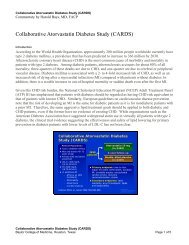Relationship of Glycemia to Cardiovascular Disease ... - Lipids Online
Relationship of Glycemia to Cardiovascular Disease ... - Lipids Online
Relationship of Glycemia to Cardiovascular Disease ... - Lipids Online
Create successful ePaper yourself
Turn your PDF publications into a flip-book with our unique Google optimized e-Paper software.
The Proinflamma<strong>to</strong>ry Milieu in Atheromata<br />
Is Mediated by RAGEs in Diabetes Mellitus<br />
RAGE = recep<strong>to</strong>r for advanced glycosylated end-products<br />
Reprinted from Cipollone F, et al. Circulation. 2003;108:1070–1077,<br />
with permission from Lippincott Williams & Wilkins.<br />
Slide Source<br />
<strong>Lipids</strong> <strong>Online</strong> Slide Library<br />
www.lipidsonline.org<br />
The Proinflamma<strong>to</strong>ry Milieu in Atheromata Is Mediated by RAGEs in Diabetes<br />
Mellitus<br />
In this study by Cipollone et al., carotid endarterec<strong>to</strong>my specimens from diabetic patients<br />
were found <strong>to</strong> be distinctly different from those <strong>of</strong> nondiabetic patients. This study also<br />
provided in-vivo data demonstrating that atheromata in diabetic patients may have a<br />
different pathobiology. The diabetic carotid atheroma specimens contained localized<br />
dense infiltrates <strong>of</strong> mononuclear cells expressing surface markers consistent with active<br />
inflammation. The specimens from the nondiabetic patients did not show this degree <strong>of</strong><br />
inflamma<strong>to</strong>ry infiltrate. Monocytes, macrophages, and lymphocytes reside in this region<br />
<strong>of</strong> the plaque because the recep<strong>to</strong>rs for advanced glycosylated end-products (RAGEs) are<br />
located in these areas, and the attachment <strong>of</strong> the RAGEs <strong>to</strong> the recep<strong>to</strong>r induces a<br />
chemotactic response accounting for the inflamma<strong>to</strong>ry appearance <strong>of</strong> atheroma<br />
specimens from diabetic patients. Furthermore, the density <strong>of</strong> the RAGEs was related <strong>to</strong><br />
the level <strong>of</strong> glycemia in these particular patients, thus providing a link between glycemia<br />
and vascular inflammation. The specimens from the diabetic patients expressed high<br />
concentrations <strong>of</strong> matrix metallinoproteinases in the area <strong>of</strong> inflamma<strong>to</strong>ry cells, but those<br />
<strong>of</strong> the nondiabetic patients did not.<br />
Let us now examine the possibility that the pharmacologic strategies used <strong>to</strong> lower<br />
glucose in both prediabetes and diabetes can reduce the risk <strong>of</strong> cardiovascular disease.<br />
Reference:<br />
Cipollone F, Iezzi A, Fazia M, et al. The recep<strong>to</strong>r RAGE as a progression fac<strong>to</strong>r<br />
amplifying arachidonate-dependent inflamma<strong>to</strong>ry and proteolytic response in human<br />
atherosclerotic plaques: role <strong>of</strong> glycemic control. Circulation. 2003;108:1070-1077.<br />
Source: <strong>Lipids</strong> <strong>Online</strong> Slide Library (www.lipidsonline.org) Page 5 <strong>of</strong> 36<br />
© 2009 Baylor College <strong>of</strong> Medicine, Hous<strong>to</strong>n, Texas



